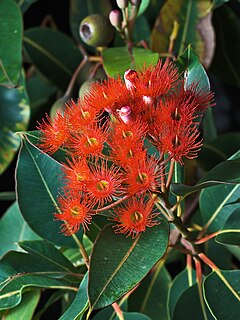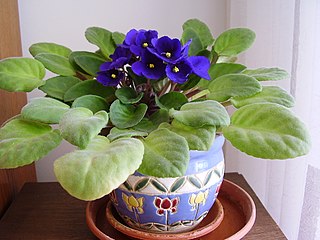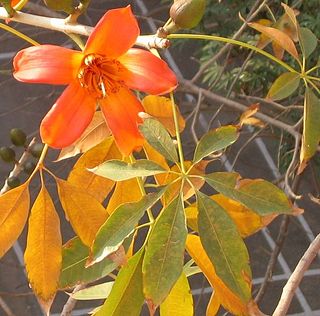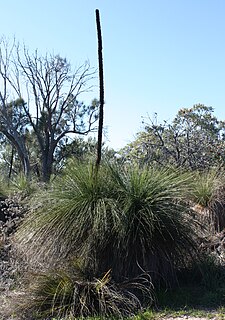
Corymbia ficifolia (syn. Eucalyptus ficifolia, commonly known as the red flowering gum, is a species of small tree that is endemic to the south-west of Western Australia. It has rough, fibrous bark on the trunk and branches, egg-shaped to broadly lance-shape adult leaves, flower buds in groups of seven, bright red, pink or orange flowers and urn-shaped fruit. It has a restricted distribution in the wild but is one of the most commonly planted ornamental eucalypts.

Gesneriaceae, the gesneriad family, is a family of flowering plants consisting of about 152 genera and ca. 3,540 species in the tropics and subtropics of the Old World and the New World, with a very small number extending to temperate areas. Many species have colorful and showy flowers and are cultivated as ornamental plants.

Bombax is a genus of mainly tropical trees in the mallow family. They are native to western Africa, the Indian subcontinent, Southeast Asia, and the subtropical regions of East Asia and northern Australia. It is distinguished from the genus Ceiba, which has whiter flowers.

Corymbia calophylla is a large and common tree in the southwest of Australia.

Banksia calophylla is a species of shrub that is endemic to Western Australia. It has a fire-tolerant, underground stem, pinnatifid leaves that have woolly hairs on the lower surface and heads of thirty to forty-five yellowish brown flowers surrounded by hairy bracts.

Casasia is a genus of flowering plants in the family Rubiaceae. These shrubs or small trees occur on the Caribbean islands and in one case in Florida. Some of the ten accepted species were formerly placed elsewhere, e.g. in the related genip-tree genus (Genipa), in Gardenia or in Randia.
Miconia calophylla is a species of plant in the family Melastomataceae. It is endemic to Peru.
Virola calophylla is a species of tree in the family Myristicaceae. It is native to Central America and South America, namely Panama, Guyana, Suriname, Brazil, Bolivia, Colombia, Ecuador and Peru.

Xanthorrhoea preissii, known as balga, is a widespread species of perennial monocot in Southwest Australia.

Dryandra ser. Aphragma is an obsolete series within the former genus Dryandra. It was first published at sectional rank by Robert Brown in 1830, and was retained at that rank until 1999, when Alex George demoted it to a series. It was discarded in 2007 when Austin Mast and Kevin Thiele sank Dryandra into Banksia.
Gardenieae is a tribe of flowering plants in the family Rubiaceae and contains about 586 species in 53 genera.
Smilax calophylla is a vine in the greenbrier family. It is native to parts of Southeast Asia as well as to northeastern Australia (Queensland).
Grevillea rara, also known as the rare grevillea, is a shrub of the genus Grevillea native to a small area in the South West region of Western Australia.
Uncaria perrottetii, known locally in the Philippines as “sungay kalabaw”, is a species of liana in the family Rubiaceae.

Casasia clusiifolia, also called the sevenyear apple, is a species of plant belonging to the family Rubiaceae. It is common in Florida.
Casasia domingensis is a plant native to the Dominican Republic, it is a part of the family Rubiaceae.
Casasia ekmanii is a plant belonging to the family Rubiaceae, it is native to Haiti.
Casasia jacquinioides is a species of plant belonging to the family Rubiaceae.
Casasia samuelssonii is a plant belonging to the family Rubiaceae. It is found in the Dominican Republic.
Sericolea is a genus of flowering plants belonging to the family Elaeocarpaceae.








